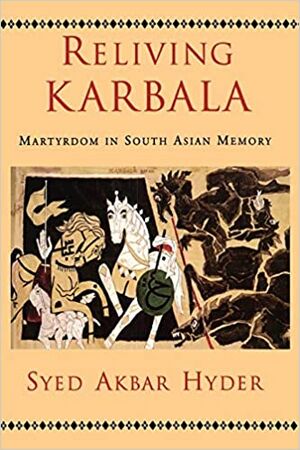Reliving Karbala: Martyrdom in South Asian Memory
 | |
| Author | Syed Akbar Hyder |
|---|---|
| Language | English |
| Genre | Shi'ism Islam |
| Published | 2008 |
| Publisher | Oxford University Press |
| Pages | 272 |
According to American Journal of Islamic Social Sciences the book Reliving Karbala: Martyrdom in South Asian Memory is an invaluable resource from which students of various disciplines will benefit. It offers an original, complex, and nuanced view of religious symbols.
About the author[edit | edit source]
Syed Akbar Hyder is HUF's Associate Director and Associate Professor of Asian Studies and Islamic Studies at the University of Texas at Austin. He earned his Ph.D. in Near Eastern Languages and Civilizations from Harvard University and holds a B.A. in Political Science from Texas A&M University. His primary research interests lie in South Asian aesthetics, particularly those related to Urdu literature and mystical Muslim traditions. Professor Hyder is also leading a team of language instructors in setting up ILR-based assessment tools for Urdu. In his spare time, Professor Hyder provides expert testimony and consultation on a pro-bono basis to individuals and families seeking asylum in the United States. He works closely with K-12 educators working on incorporating the studies of the humanities into the curriculum of their schools. Professor Hyder teaches in Austin, as well as in the university's overseas program in India (Delhi, Lucknow, Jaipur, and Hyderabad). He also teaches courses cross-listed in History, Comparative Literature, Middle Eastern Studies, and Religious Studies.
About the book[edit | edit source]
This book published in Oxford University Press; 1st edition (September 1, 2008) has 272 pages and best sellers rank of 2,841,232 in Books.
This study has two main objectives: to provide an insight into the multiple, interdependent lives of Karbala as they furnish a sense of interlocking communal, religious, and literary identities; and to offer an ethnographic prism through which the lived contexts and spirited memories of many Muslims and non-Muslims can be refracted over the expanses of time and space.
Hyder believes that the signification of events and symbols is tied to the context of their signification. Three complementary significations in which he read the event of Karbala are taken as corresponding to broadly recognizable contexts, or interpretive communities, in which Karbala is construed; though such divisions can and often do overlap. The three contexts are: Part I the commemorative Shii context; Part II the celebratory Sufi context; and Part III the socioreligious reformist context.
Abstract of chapters[edit | edit source]
Part I: Commemoration of Karbala[edit | edit source]
- Chapter 1, Visions and Re-visions of Karbala
In this chapter the author examines the institution of Shii commemoration, he orients the readers toward the texts and contexts of the majlis by reflecting on Shii commemorations. He discusses the aesthetics of the majlis by focusing on Karbala’s contribution to Urdu literature and poetics. This discussion entwines itself around issues of shifting cultural and regional codes, that in turn facilitate a localization of Karbala in South Asia. He also draws attention to the ways in which Karbala is invoked to mediate the personal sorrows of the devotees.
- Chapter 2, Mourning in Migrant Spaces
This chapter takes us from South Asian accounts to an appraisal of the Shii commemorations of Texas. Thus, we see the reflection of Karbala’s legacy across temporal and geographical sites, interweaving memories of home and migrancy.
- Chapter 3, Commemorative Politics and Poetics
In this chapter, Hyder explores the ways in which majlises serve to historicize Karbala and bring to the fore a variety of social concerns. Since the issue of the succession to the Prophet has its repercussions on the way many Shias read Karbala, by recalling the Karbala event, these Shias emphasize an alternative and resistive reading of Islamic history. It is through such a discourse of resistance that a sectarian Shii identity is reinforced. A significant part of this chapter is reserved for a discussion of gender dynamics that shape the narratives of femininity through the elaboration of the role of Husain’s sister, Zainab. One of the first appraisals of Karbala is presented from Zainab—who had accompanied Hussain to Karbala and was her brother’s comrade in spirit. Thus, traditions of devotion and resistance are ascribed to her.
Part II: Celebration of Karbala[edit | edit source]
- Chapter 4, Lyrical Martyrdom
In this chapter of the book, the author discusses the larger context of Sufism, and then delves into images of martyrdom, often improvised through arbitrary versified insertions, and the manner in which these images seek to sublimate the base self into the higher, loving self of God’s creation. Karbala in qawwalis appears in a panorama of poetic citations that are conjured up at the discretion of the performer(s), and often also according to the stipulation of the patron.
Part III: Emulation of Karbala[edit | edit source]
- Chapter 5, Iqbal and Karbala
This chapter analyzes the role played by Muhammad Iqbal, the most prominent twentieth-century exponent of pan-Islamic socioreligious reform, in marginalizing a Shii-coded reading of Karbala in favor of a more transsectarian one. Iqbal, a Sunni, brings to a reformist fruition the discourse of martyrdom cultivated by Sufis. This chapter concludes by pointing to the heterogeneity of the engagements with Iqbal’s rearticulation of Karbala, in the works of Iqbal’s contemporaries and followers, as well as in the writings of modern Iranian intellectuals.
- Chapter 6, From Communal to Ecumenical
This chapter deals primarily with Urdu Progressive Literature, and shows how this important twentieth-century literary movement, in spite of its claims to secularism, frames Karbala as an unavoidable ecumenical corollary to both transsectarian and transnational revolutionary struggles. This chapter also provides the reader with an understanding of how the symbol of Karbala became transcommunal during the heyday of Indian nationalism, and how its invocation played an important part in the discourses of non-Muslim reformer-writers like Munshi Premchand and Mahatma Gandhi.